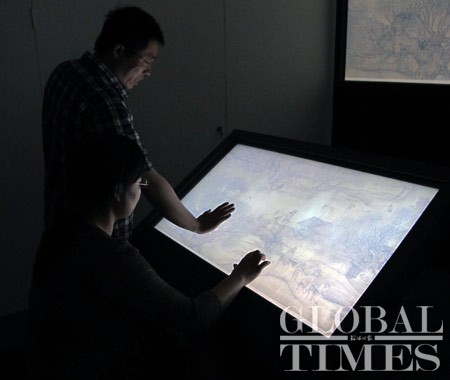Experience an ancient painting with technology
An interactive multimedia exhibition focusing on an ancient Chinese painting that has long been hailed as a masterpiece was launched Wednesday in the Palace Museum in Beijing.
|
|
|
Reporters experience the multimedia system presenting Life along the Bian River at the Pure Brightness Festival, in the Palace Museum in Beijing, June 23, 2010. [Global Times] |
The project is a joint initiative of the Beijing Palace Museum, Microsoft Research Asia and Peking University, who developed the multimedia presentation together, and it is now open to the public.
Northern Song Dynasty (AD 960-1127) artist Zhang Zeduan painted Life along the Bian River at the Pure Brightness Festival on a scroll measuring more than 5 meters. It is one of the most famous cultural art pieces in China and depicts hundreds of people engaged in activities ranging from playing string instruments to paying taxes, and gives a vivid idea of the life at the time.
The painting can be experienced in this new exhibition in the form of a high-resolution image, and visitors can also listen to short stories with hundreds of voice recordings and sound effects that recount the scenes that Zhang painted.
A panning and zooming interface allows the public to navigate the giant image, obviously without touching the original painting.
The scripts for the audio recordings were compiled by researchers from the Beijing Palace Museum, who are experts in the history and ancient culture of the period. The audio is in Putonghua with the accent of Kaifeng, China's Henan Province, in order to accurately convey the life of the Northern Song Dynasty. Other sound effects are simulated by professional foley mixers.
"The Kaifeng accent can present the ancient painting more vividly and bring the visitors back to ancient times," Hu Chui, director of the Information Center of the Palace Museum told the Global Times. "But we tried to use more Putonghua to make it easier to understand."
Hu added that even though the presentation is in Chinese, international visitors can still enjoy the visual aspect of the ancient painting and also gain some understanding of the period.
"It would be weird if people shown in an ancient Chinese painting were to say 'Good morning!' in English," he added.
The system is the first of its kind to provide a solution to the 3D modeling of the moving-focus, a famous Chinese painting technique that is different from the fixed viewpoint of Western paintings.
Microsoft Research Asia worked with Peking University to develop an algorithm that can intelligently infer the positions of the annotations in the 3D world depicted in the moving-focus painting. And the audio is included in the painting to produce audio-visual consistency perception.
When a visitor navigates on the multi-touch screen, the user interface estimates the 3D position of the visitor's viewpoint from his or her actions.
This activates the corresponding embedded stories to synthesize a realistic stereo audio field according to the viewer's orientation and distances from the sound sources in the hidden space.
"We aim to use modern techniques to promote the protection of our cultural heritage," said Hong Xiaowen, managing director of Microsoft Research Asia.
 0
0 








Go to Forum >>0 Comments